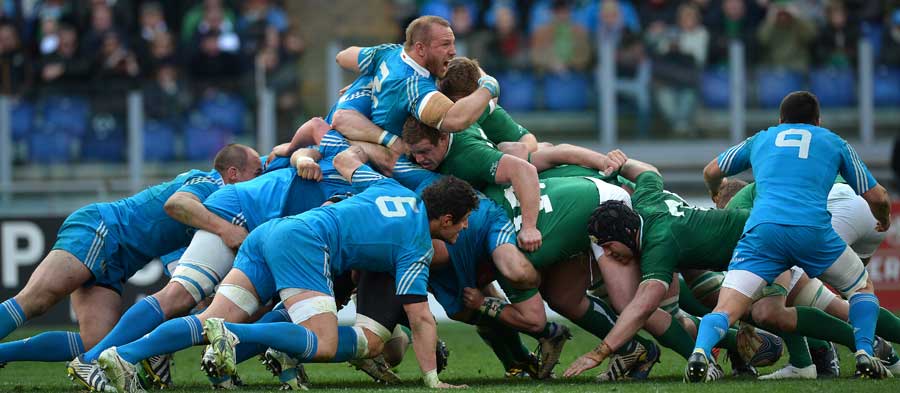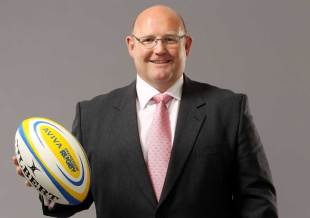|
ESPNscrum on Scrums
The stakeholders on the new scrums
Tom Hamilton
August 12, 2013

A failed scrum © Getty Images
Enlarge
Have a listen to the views of Brett Gosper and David Barnes
%]
The new scrum call by Bristol scrum coach Matt Ferguson
This weekend sees the start of the new scrum calling sequence 'crouch, bind, set' with both the Rugby Championship and the Top 14 adopting the revised method of engagement. ESPN spoke to International Rugby Board chief executive Brett Gosper, the Rugby Players' Association rugby director David Barnes and Premiership Rugby's rugby director Phil Winstanley about their views on the new set of rules.
Brett Gosper- International Rugby Board's chief executiveOn the changes: "This outcome of a new scrum engagement call has been driven by player welfare. It was not driven by the direct desire to change outcomes in scrums. It was initially and purposely there to improve player welfare. We believe this new protocol will lead to greater player safety in the long-term, this is a positive step. "There are reasons to be optimistic that this will lead to higher successful outcomes in scrummaging and a more aesthetic game as we go forward as well. While we're optimistic, we will have to see how the trials progressed. It may not answer all the problems in the scrum but it is a step forward in the right direction." On the referee's role: "It is critical the referees get it right at the elite level. There will be lots of trials on this and of course the timing of the introduction of the ball, the waiting for the scrum to be steady and squared and we are looking to impose the existing law of the straight feed which we also believe we add to the stability of it. "These are new habits that referees have to pick up and like any trial, I'm sure in the introductory period there will be some hiccups and we have to see how it develops over the full year. Referees are incredibly important in this process, but it's also down to the coaches and the players and we are hopeful there will be a positive attitude to the whole process."

© Getty Images
Enlarge
On the future of the scrums: "They are an important part of the game and they are a real contest in rugby union. It's an important part of rugby and no, there was never a discussion to do away with the scrum. It's an important participatory part of the game and important spectacle when it's managed in the right way." On whether we will see a new scrum rule in a year's time: "I hope not. I hope this moves us to a better position. For the scrum area, hopefully this will be successful in the way it's implemented and therefore put a stop to any changes to any protocol and so on. But I wouldn't rule it out as a possibility because until the trials take place, we can't be sure of the outcomes. It's why we trial it globally for a full year and we will learn a lot from this, but hopefully the main thing we will learn is that it is a successful process."
David Barnes- The Rugby Players' Association's rugby directorOn the Scrum Steering project which helped bring in the new calls: "I've been part of the project since 2011 which was set up at the University of Bath to measure the exact forces in the scrum. There have been a lot of studies into the scrum but nothing had been done technically to research the full impact. It was started up on a static scrum machine to look at the forces and that came from different types of hits whether it was 'crouch, touch, pause, engage' or 'crouch, touch, set' as well as various other options such as removing the back-row from the hit and other things.

© Getty Images
Enlarge
"As we went through that process we started to understand what forces were involved and the huge physical impact the scrum has on people. We continued that research and moved on to a live study. As we moved forward the scrum had become a big talking point in the game and there had been a number of discussions about the collapsed scrums. So we started looking at from two different perspectives - the impact on the player and ways of reducing the number of collapses in the scrum." On the improvement of player welfare in the scrums: "It's better to look at the game as a whole. We have seen a reduction in the number of catastrophic injuries in the scrum. They are better refereed and better technically taught. I think the RFU has done great work educating player's right through the age groups on how to scrum and that has paid off. "What we saw in the professional side of the game was that the impacts were so huge in the scrum that it was having a direct consequence on player welfare. Certainly players from my era, there would be very few who would get through their career without having a cervical disk operation or a back operation. We all loved playing the game and we all knew what we were doing but anything we can do to reduce the amount of pressure in the scrum and allow players to play longer is only a good thing for the game.
Phil Winstanley- Rugby director at Premiership RugbyOn whether there's confidence there won't be a new set of rules this time next season: "No I'm not confident. I fully understand why the International Rugby Board has felt the need to get involved with the scrum engagement, probably for two reasons. One, from a player welfare medical point-of-view and secondly because of the repeated infringements and resets we've had over the last couple of years.

© Getty Images
Enlarge
"That having been said, whilst understanding the solution I'm not sure that that won't create other issues which we may have to deal with over the course of the next year or two years. "At the moment when the front-rows engage there's a certain amount of momentum through the hit which stabilises the scrum. And if you remove that explosive engagement then you potentially create a bit of a wrestling match for superiority between the two front-rows. And from that we may see more scrums stood up, or more scrums stood down, we just don't know. Until we've been through the trial we will not know that." On differing interpretations of the scrum: "I just hope we get uniformity throughout the world. We saw in the summer in the Lions series that we have some different interpretations of what is legal and what isn't legal. "Theoretically it should be pretty straight forward - these are the laws, this is what is acceptable and this is how we are going to referee it. But I'm not sure we get that uniformity. There certainly is a different view of what is permissible in the different hemispheres. That shouldn't be the case." On who holds the responsibility with the new scrum and making it work: "Like all parts of the game, everyone has to buy in. People have got to understand what the laws are. However, the very nature of competitive sport is that players, coaches and teams will push the laws to the utmost extent in order to get the advantage. That's why we have the referee and the referee then determines whether they have gone too far or it's appropriate. If that's consistent, then we should get a uniform interpretation throughout the globe." © ESPN Sports Media Ltd Tom Hamilton is the Assistant Editor of ESPNscrum.
|
Live Sports
Communication error please reload the page.
-
Football
-
Cricket
-
Rugby
-
- Days
- Hrs
- Mins
- Secs
F1 - Abu Dhabi GP
Abu Dhabi Grand Prix December 11-131. Max Verstappen ()
2. Valtteri Bottas (Mercedes)
3. Lewis Hamilton (Mercedes)
4. Alexander Albon ()
5. Lando Norris ()
6. Carlos Sainz Jr ()
-
ESPNOtherLive >>
Darts - Premier League
Golf - Houston Open
Snooker - China Open
Tennis - Miami Open

